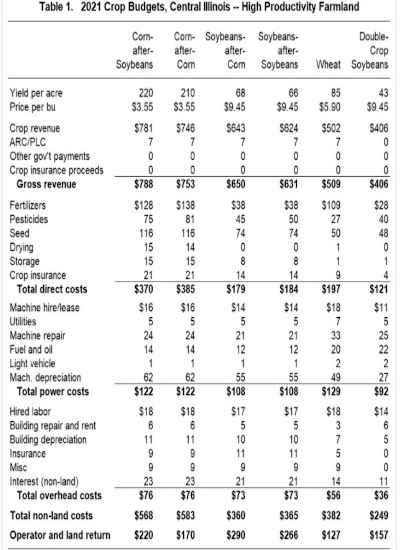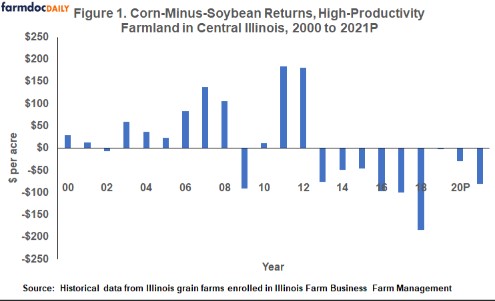By Gary Schnitkey and Krista Swanson et.al
Department of Agricultural and Consumer Economics
University of Illinois
By Carl Zulauf
Department of Agricultural, Environmental and Development Economics
Ohio State University
The 2021 Crop Budgets have been revised from the original August release. Corn and soybean prices have been increased in revised budgets, leading to higher corn and soybean return projections for 2021. In most years, soybeans have been more profitable than corn since 2012. In 2021, soybeans again are projected to be more profitable than corn.
2012 Crop Budgets
Table 1 shows budgets for crops produced in central Illinois on high-productivity farmland. Budgets for northern Illinois, central Illinois with low-productivity farmland, and southern Illinois are available in the management section of farmdoc (see here). The publication entitled “Revenues and Costs for Illinois Crops” which shows returns from 2014 to projections for 2021 have been revised as well (see here).

Two major changes have occurred in 2021 budgets. First, corn and soybean prices have been increased. The revised budgets use a $3.55 per bushel price for corn compared to $3.40 in August. The soybean price is $9.45 in revised budgets compared to $8.50 per bushel in August. These prices reflect grain to be produced in 2021 and sold in 2021 and 2022, and not prices for 2020 production. Prices on futures contracts traded on the Chicago Mercantile Exchange, along with 2021 fall delivery bids, are used as the basis for making 2021 projections. This sets of prices is substantially higher in October as compared to August, reflecting increases in prices that have been recently occurring (see farmdoc daily, October 6, 2020).
Also revised in the October budgets for 2021 were commodity title payments in the form of Agricultural Risk Coverage (ARC) and Price Loss Coverage (PLC) payments. ARC/PLC payments have been lowered from $30 in August budgets to $7 per acre. Prices used in the 2021 budgets would result in PLC payments for corn but no payments on soybeans. ARC at the county level could trigger for some counties if lower yields result. Note that ARC/PLC payments are the same whether corn or soybeans are planted because commodity title payments are made on base acres and not planted acres. As a result, payments are averaged across both crops in the budgets.
With this October release, we have added a budget for soybeans-after-soybeans (see Table 1). Over the past several years, soybeans have been more profitable than corn, which may lead to considering planting soybeans on farmland previously in soybeans. Compared to soybeans-after-corn, the soybeans-after-soybeans budget has a yield 2 bushels per acre lower and pesticide costs $5 per acre higher.
Overall Level of Returns
Operator and land return is projected to be $220 per acre for corn-after-soybeans and $290 per acre for soybeans-after-corn. A rotation with 50% corn and 50% soybeans would have a $255 per acre return. Cash rent on high-productivity farmland in central Illinois is likely to average $275 per acre, leaving a -$20 per acre return. Projections of negative returns have been typical in the past several years if 1) ad hoc Federal payments are not included in budgets and 2) yields are at trend levels. Much higher ne
Note that crop budgets in Table 1 do not include any other government payments besides the farm program payments. In the past three years, larger Federal payments have occurred through the Market Facilitation Program (MFP) and Coronavirus Food Assistance Program (CFAP). For soybean on high-productivity farmland, these payments have averaged $122 per acre in 2018, $85 per acre in 2019, and $80 per acre in 2020. Whether or not these ad hoc Federal payments continue in 2021 is an open question.
Also, note that yields in Table 1 are at trend levels. Aside from 2019 in which adverse weather affected production, yields have been above-trend levels in recent years. A continuation of above-trend yields in 2021 will result in higher incomes if prices do not decline. A 230 bushel per acre corn yield would result in an operator and land return of $256 per acre, and a 72 bushel per acre soybean yield would result in an operator and land return of $327 per acre. Under these yields, a corn-soybean rotation results in a $292 per acre return over the blended acre.
As has been the case for the past several years, at current expected price levels, positive returns to cash rent farmland require a combination of above-trend yields and continued ad-hoc Federal payments.
Corn versus Soybeans
Operator and land returns are projected to be $220 for corn-after-soybeans and $290 per acre for soybeans-after-corn, suggesting that soybeans will be more profitable than corn. The soybean-after-soybeans budget has a $266 per acre return, compared to $220 per acre for corn-after-soybeans. Even given a lower yield projection for a situation where soybeans follow soybeans, soybeans are projected more profitable than corn.
Figure 1 shows corn returns minus soybean returns from 2000 to projections for 2021 (see the Revenues and Costs for Illinois Crops publication for values of returns in recent years here). As shown in Figure 1, soybeans have been more profitable than corn on high-productivity farmland in central Illinois. There was a change in relative returns in 2013. From 2000 to 2012, corn typically was more profitable than soybeans. Since 2012, soybeans typically have been more profitable than corn. Roughly in 2013, the increase in corn use in ethanol came to an end. Since this time, soybeans have been more profitable than corn.

Summary
Revised 2021 Crop Budgets have higher prices compared with the August release, leading to higher projections of returns for corn and soybean production. Even with higher prices, either above-trend yields or continued ad hoc Federal payments are needed for rotational returns to exceed average cash rents. Soybeans again are projected to be more profitable than corn.
Source : illinois.edu